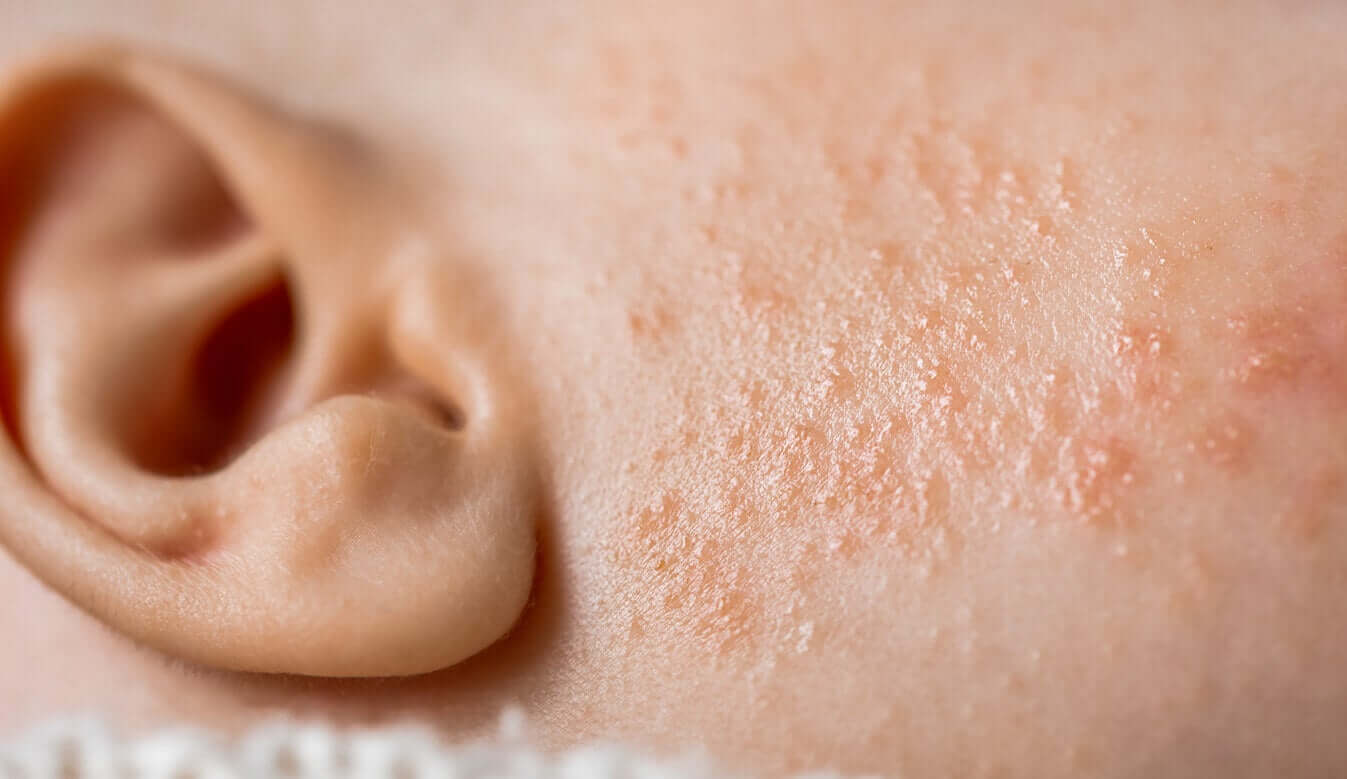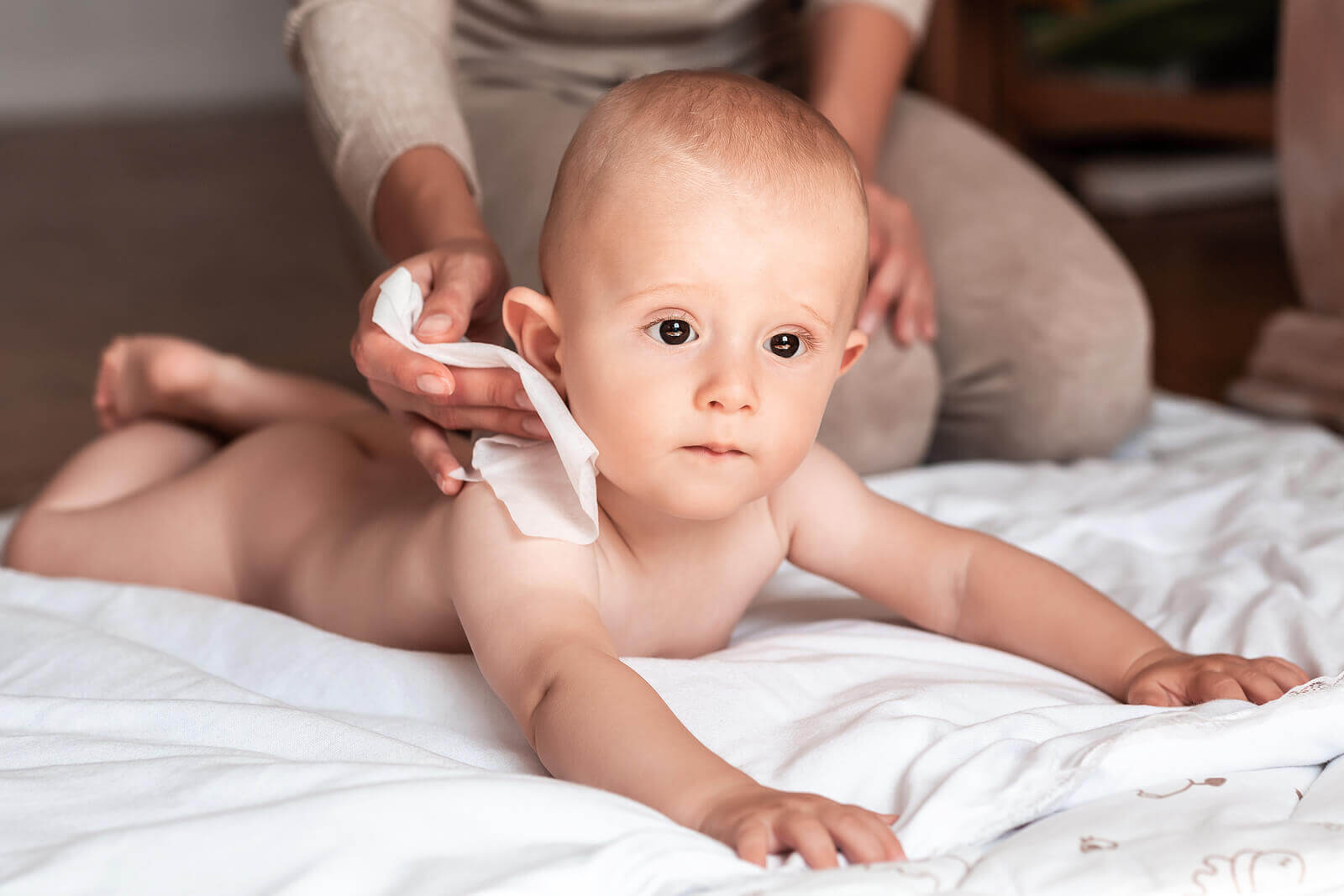Skin Rashes on Babies: What You Should Know


Written and verified by the dermatologist Maria del Carmen Hernandez
Skin rashes in babies are usually very treatable conditions that aren’t serious. However, they cause great concern for parents and, in a small number of cases, they’re red flags for more complex diseases. We’ll tell you why they occur and when you should consult your doctor.
The characteristics of babies’ skin
Babies have sensitive and delicate skin and an immune system that hasn’t yet fully developed. Therefore, they’re especially susceptible to irritation and infection.
Rashes or breakouts on the skin occur for several reasons: Heat, allergies, contact with certain fragrances, humidity, friction, or direct aggression from chemicals or certain fabrics. As a result of this heterogeneity, the area that’s affected will depend on the cause.
The signs and symptoms that characterize skin rashes are the following:
- Redness of the skin
- Itching in the affected area
- Lesions with the appearance of papules (small palpable points) or with yellowish scales, which are transitory and can migrate from one site to another.
The most frequent skin rashes in babies
Some of the skin rashes in babies appear during the first days of life and arouse great concern in parents. But the most common rashes resolve on their own over the course of the next few weeks. Next, we’ll mention the most common skin rashes in babies.
Infant acne

Infant acne occurs within the first 30 days of the baby’s life and is related to the passing of maternal hormones through the placenta.
In general, the lesions appear as small white-tipped papules (or comedones) on a base of slightly reddened skin.
These are benign and transitory lesions, which disappear on their own when hormone levels stabilize.
Cradle cap
Cradle cap is a non-inflammatory and self-limited condition that occurs between the third and fourth week of the infant’s life. It disappears spontaneously and isn’t associated with any complications.
It’s characterized by the presence of palpable erythematous (reddish) plaques on the skin, with yellowish scales on top. In general, they’re located in the areas of high concentration of fat, such as the scalp, ears, and the T line of the face.
Babies don’t feel itchy or sore from cradle cap and are therefore not a cause for sleep interruptions or feeding difficulties.
Diaper rash
Diaper rash encompasses all skin inflammations that occur in the area covered by the diaper. In general, it’s related to the direct action of certain irritants, such as fecal matter, urine, and humidity.
After 48 to 72 hours after the irritation begins, an infection usually develops by some germ of the normal flora of the skin. However, diaper rash is a self-limited disorder, which tends to disappear within three days.
Fifth disease
Fifth disease, or slapped cheek syndrome, is an eruptive illness caused by parvovirus B19. The way children contract the disease is through contact with respiratory droplets infected by this germ.
It’s characterized by intense redness on the baby’s cheeks, which is accompanied by a mild rash on the rest of the body and fever. This rash can be itchy (pruritic) and usually disappears within a week.
Drool rash
The rash, which is generated by the baby’s drool, is very common, as the salivary glands are in full development, as is the case with teething. Therefore, the use of a pacifier, constant drooling, and food particles are some of the factors that influence this condition.
The lesions caused by drool resolve spontaneously in a matter of weeks.
Hand, foot, and mouth disease
Hand, foot, and mouth disease is a mild and highly contagious viral condition caused by the coxsackievirus.
It characteristically appears in the form of ulcerative lesions in the mouth and a rash on the hands and feet.
Although there’s no specific treatment for the disease, hygiene measures can be implemented to reduce the risk of superinfection with bacteria from normal flora.
Heat rash
The structures of the skin of babies are yet to fully develop. Therefore, hot or humid climates cause a rash by trapping drops of sweat under the skin tissue.
The clinical manifestations of this condition are variable, from tiny vesicles (blisters) on the surface of the skin to deeper, red bumps.
In general, it’s a self-limited condition and tends to go away after a while.
Tips to prevent skin rashes in babies
Skin rashes in babies are very common and usually disappear after a few days. Some useful recommendations to avoid their appearance are the following:
- Change their diaper frequently and use protective cream with zinc oxide as an insulator.
- Gently loosen cradle cap with coconut oil to avoid skin injuries.
- Use laundry detergents that don’t contain irritants and are also hypoallergenic.
- Dress your baby in light cotton clothing and avoid dressing them child too warmly.

Skin rashes in babies: When to see the doctor
Skin rashes in babies are usually minor injuries, but they can also be a red flag for potentially serious illnesses.
It’s important to consult a pediatrician when one or more of the following signs appear:
- Your baby looks sick, rejects food, and is very down.
- The itching is intense and causes a lot of irritability.
- The rash is accompanied by a fever.
- The color of the skin or mucous membranes changes to a pale, grayish, or bluish tint.
Whenever these signs and symptoms appear or you have questions about the appearance of your baby’s skin, try to contact your pediatrician to evaluate your child and provide you with the necessary guidelines.
Skin rashes in babies are usually very treatable conditions that aren’t serious. However, they cause great concern for parents and, in a small number of cases, they’re red flags for more complex diseases. We’ll tell you why they occur and when you should consult your doctor.
The characteristics of babies’ skin
Babies have sensitive and delicate skin and an immune system that hasn’t yet fully developed. Therefore, they’re especially susceptible to irritation and infection.
Rashes or breakouts on the skin occur for several reasons: Heat, allergies, contact with certain fragrances, humidity, friction, or direct aggression from chemicals or certain fabrics. As a result of this heterogeneity, the area that’s affected will depend on the cause.
The signs and symptoms that characterize skin rashes are the following:
- Redness of the skin
- Itching in the affected area
- Lesions with the appearance of papules (small palpable points) or with yellowish scales, which are transitory and can migrate from one site to another.
The most frequent skin rashes in babies
Some of the skin rashes in babies appear during the first days of life and arouse great concern in parents. But the most common rashes resolve on their own over the course of the next few weeks. Next, we’ll mention the most common skin rashes in babies.
Infant acne

Infant acne occurs within the first 30 days of the baby’s life and is related to the passing of maternal hormones through the placenta.
In general, the lesions appear as small white-tipped papules (or comedones) on a base of slightly reddened skin.
These are benign and transitory lesions, which disappear on their own when hormone levels stabilize.
Cradle cap
Cradle cap is a non-inflammatory and self-limited condition that occurs between the third and fourth week of the infant’s life. It disappears spontaneously and isn’t associated with any complications.
It’s characterized by the presence of palpable erythematous (reddish) plaques on the skin, with yellowish scales on top. In general, they’re located in the areas of high concentration of fat, such as the scalp, ears, and the T line of the face.
Babies don’t feel itchy or sore from cradle cap and are therefore not a cause for sleep interruptions or feeding difficulties.
Diaper rash
Diaper rash encompasses all skin inflammations that occur in the area covered by the diaper. In general, it’s related to the direct action of certain irritants, such as fecal matter, urine, and humidity.
After 48 to 72 hours after the irritation begins, an infection usually develops by some germ of the normal flora of the skin. However, diaper rash is a self-limited disorder, which tends to disappear within three days.
Fifth disease
Fifth disease, or slapped cheek syndrome, is an eruptive illness caused by parvovirus B19. The way children contract the disease is through contact with respiratory droplets infected by this germ.
It’s characterized by intense redness on the baby’s cheeks, which is accompanied by a mild rash on the rest of the body and fever. This rash can be itchy (pruritic) and usually disappears within a week.
Drool rash
The rash, which is generated by the baby’s drool, is very common, as the salivary glands are in full development, as is the case with teething. Therefore, the use of a pacifier, constant drooling, and food particles are some of the factors that influence this condition.
The lesions caused by drool resolve spontaneously in a matter of weeks.
Hand, foot, and mouth disease
Hand, foot, and mouth disease is a mild and highly contagious viral condition caused by the coxsackievirus.
It characteristically appears in the form of ulcerative lesions in the mouth and a rash on the hands and feet.
Although there’s no specific treatment for the disease, hygiene measures can be implemented to reduce the risk of superinfection with bacteria from normal flora.
Heat rash
The structures of the skin of babies are yet to fully develop. Therefore, hot or humid climates cause a rash by trapping drops of sweat under the skin tissue.
The clinical manifestations of this condition are variable, from tiny vesicles (blisters) on the surface of the skin to deeper, red bumps.
In general, it’s a self-limited condition and tends to go away after a while.
Tips to prevent skin rashes in babies
Skin rashes in babies are very common and usually disappear after a few days. Some useful recommendations to avoid their appearance are the following:
- Change their diaper frequently and use protective cream with zinc oxide as an insulator.
- Gently loosen cradle cap with coconut oil to avoid skin injuries.
- Use laundry detergents that don’t contain irritants and are also hypoallergenic.
- Dress your baby in light cotton clothing and avoid dressing them child too warmly.

Skin rashes in babies: When to see the doctor
Skin rashes in babies are usually minor injuries, but they can also be a red flag for potentially serious illnesses.
It’s important to consult a pediatrician when one or more of the following signs appear:
- Your baby looks sick, rejects food, and is very down.
- The itching is intense and causes a lot of irritability.
- The rash is accompanied by a fever.
- The color of the skin or mucous membranes changes to a pale, grayish, or bluish tint.
Whenever these signs and symptoms appear or you have questions about the appearance of your baby’s skin, try to contact your pediatrician to evaluate your child and provide you with the necessary guidelines.
All cited sources were thoroughly reviewed by our team to ensure their quality, reliability, currency, and validity. The bibliography of this article was considered reliable and of academic or scientific accuracy.
- Ro BI, Dawson TL. The role of sebaceous gland activity and scalp microfloral metabolism in the etiology of seborrheic dermatitis and dandruff. J Investig Dermatol Symp Proc. 2005 Dec;10(3):194-7. doi: 10.1111/j.1087-0024.2005.10104.x. PMID: 16382662.
- Bergman JN, Eichenfield LF. Neonatal acne and cephalic pustulosis: is malassezia the whole story? Arch Dermatol. 2002 Feb;138(2):255-7. doi: 10.1001/archderm.138.2.255. PMID: 11843648.
- Prasad HR, Srivastava P, Verma KK. Diaper dermatitis–an overview. Indian J Pediatr. 2003 Aug;70(8):635-7. doi: 10.1007/BF02724253. PMID: 14510084.
- O’Connor NR, McLaughlin MR, Ham P. Newborn skin: Part I. Common rashes. Am Fam Physician. 2008 Jan 1;77(1):47-52. PMID: 18236822.
- National Health Service United Kingdom. Rashes in babies and children. NHS website [Internet]. Acceso 20 septiembre 2021. Disponible en: https://www.nhs.uk/conditions/rashes-babies-and-children/
- Williams E. La quinta enfermedad (parvovirus B19). Healthy Children – American Academy of Pediatrics website. [Internet] 2020. Acceso 20 septiembre 2021. Disponible en: https://www.healthychildren.org/Spanish/health-issues/conditions/skin/Paginas/Fifth-Disease-Parvovirus-B19.aspx?gclid=Cj0KCQjw9O6HBhCrARIsADx5qCQ0g2HLvDwsmhdnMDqEe_Yri1AbFx0rRy9cLI7kHx6qd9bz6AHFRRIaAjBvEALw_wcB
This text is provided for informational purposes only and does not replace consultation with a professional. If in doubt, consult your specialist.








